A) 3 bushels of wheat and 6 pounds of beef.
B) 3.5 bushels of wheat and 5.5 pounds of beef.
C) 4 bushels of wheat and 5 pounds of beef.
D) 7 bushels of wheat and 11 pounds of beef.
F) A) and C)
Correct Answer

verified
Correct Answer
verified
Multiple Choice
Figure 3-6

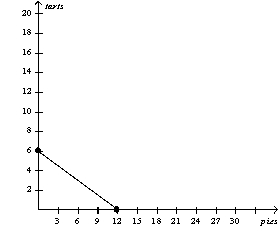
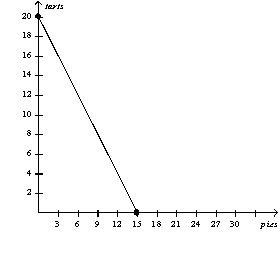 -Refer to Figure 3-6. Maxine has an absolute advantage in the production of
-Refer to Figure 3-6. Maxine has an absolute advantage in the production of
A) both goods and a comparative advantage in the production of pies.
B) both goods and a comparative advantage in the production of tarts.
C) neither good and a comparative advantage in the production of pies.
D) neither good and a comparative advantage in the production of tarts.
F) A) and D)
Correct Answer

verified
Correct Answer
verified
True/False
If a country has a lower opportunity cost than its potential trading partner, the country should decide to be self-sufficient.
B) False
Correct Answer

verified
Correct Answer
verified
Multiple Choice
Suppose that a worker in Radioland can produce either 4 radios or 1 television per year, and a worker in Teeveeland can produce either 2 radios or 4 televisions per year. Each nation has 100 workers. Also suppose that each country completely specializes in producing the good in which it has a comparative advantage. If Radioland trades 100 radios to Teeveeland in exchange for 100 televisions each year, then each country's maximum consumption of new radios and televisions per year will be
A) 100 radios, 300 televisions in Radioland and 300 radios, 100 televisions in Teeveeland.
B) 300 radios, 100 televisions in Radioland and 100 radios, 300 televisions in Teeveeland.
C) 200 radios, 100 televisions in Radioland and 100 radios, 200 televisions in Teeveeland.
D) 300 radios, 100 televisions in Radioland and 100 radios, 400 televisions in Teeveeland.
F) A) and D)
Correct Answer

verified
Correct Answer
verified
Multiple Choice
Table 3-18
Chris and Tony's Production Opportunities
 -By definition, exports are
-By definition, exports are
A) limits placed on the quantity of goods brought into a country.
B) goods in which a country has an absolute advantage.
C) people who work in foreign countries.
D) goods produced domestically and sold abroad.
F) A) and D)
Correct Answer

verified
Correct Answer
verified
True/False
Trade allows a country to consume outside its production possibilities frontier.
B) False
Correct Answer

verified
Correct Answer
verified
Multiple Choice
Figure 3-6

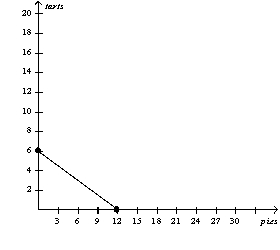
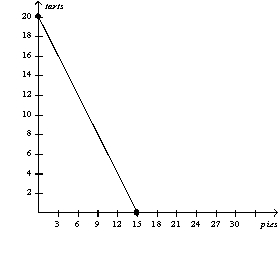 -Refer to Figure 3-6. If Daisy must work 2.5 hours to make each pie, then her production possibilities frontier is based on how many hours of work?
-Refer to Figure 3-6. If Daisy must work 2.5 hours to make each pie, then her production possibilities frontier is based on how many hours of work?
A) 6 hours
B) 7.5 hours
C) 37.5 hours
D) 50 hours
F) B) and D)
Correct Answer

verified
Correct Answer
verified
True/False
International trade can make some individuals within a country worse off, even as it makes the country as a whole better off.
B) False
Correct Answer

verified
Correct Answer
verified
Multiple Choice
People who provide you with goods and services
A) are acting out of generosity.
B) do so because they get something in return.
C) have chosen not to become interdependent.
D) are required to do so by the government.
F) All of the above
Correct Answer

verified
Correct Answer
verified
True/False
Opportunity cost measures the trade-off between two goods that each producer faces.
B) False
Correct Answer

verified
Correct Answer
verified
Multiple Choice
Table 3-18
Chris and Tony's Production Opportunities
 -By definition, imports are
-By definition, imports are
A) people who work in foreign countries.
B) goods in which a country has an absolute advantage.
C) limits placed on the quantity of goods leaving a country.
D) goods produced abroad and sold domestically.
F) A) and B)
Correct Answer

verified
Correct Answer
verified
Multiple Choice
An economy's production possibilities frontier is also its consumption possibilities frontier
A) under all circumstances.
B) under no circumstances.
C) when the economy is self-sufficient.
D) when the rate of tradeoff between the two goods being produced is constant.
F) A) and B)
Correct Answer

verified
Correct Answer
verified
True/False
For international trade to benefit a country, it must benefit all citizens of that country.
B) False
Correct Answer

verified
Correct Answer
verified
Multiple Choice
Figure 3-9

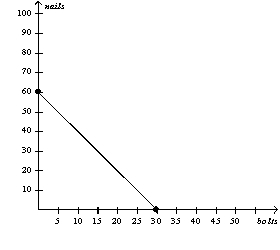
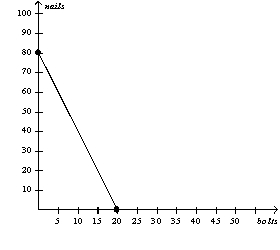 -Refer to Figure 3-9. If Uzbekistan and Azerbaijan each divides its time equally between making bolts and making nails, then total production is
-Refer to Figure 3-9. If Uzbekistan and Azerbaijan each divides its time equally between making bolts and making nails, then total production is
A) 15 bolts and 40 nails.
B) 25 bolts and 70 nails.
C) 30 bolts and 80 nails.
D) 50 bolts and 140 nails.
F) A) and D)
Correct Answer

verified
Correct Answer
verified
Multiple Choice
Figure 3-8

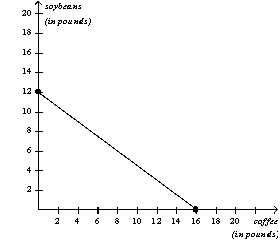
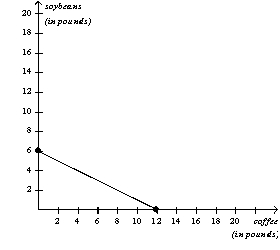 -Refer to Figure 3-8. If Chile and Colombia each divides its time equally between making coffee and making soybeans, then total production is
-Refer to Figure 3-8. If Chile and Colombia each divides its time equally between making coffee and making soybeans, then total production is
A) 12 pounds of coffee and 12 pounds of soybeans.
B) 14 pounds of coffee and 9 pounds of soybeans.
C) 16 pounds of coffee and 6 pounds of soybeans.
D) 28 pounds of coffee and 18 pounds of soybeans.
F) All of the above
Correct Answer

verified
Correct Answer
verified
Multiple Choice
Table 3-18
Chris and Tony's Production Opportunities
 -Suppose the US and Mexico both produce semiconductors and auto parts and the US has a comparative advantage in semiconductors while Mexico has a comparative advantage in auto parts. If the US exports semiconductors to Mexico and imports auto parts from Mexico,
-Suppose the US and Mexico both produce semiconductors and auto parts and the US has a comparative advantage in semiconductors while Mexico has a comparative advantage in auto parts. If the US exports semiconductors to Mexico and imports auto parts from Mexico,
A) both countries, as a whole, will be better off.
B) all individuals in both countries will be better off.
C) both countries, as a whole, will be worse off.
D) all individuals in both countries will be worse off.
F) A) and B)
Correct Answer

verified
Correct Answer
verified
Multiple Choice
Table 3-5
Assume that England and Spain can switch between producing cheese and producing bread at a constant rate.
 -Refer to Table 3-5. The opportunity cost of 1 unit of cheese for England is
-Refer to Table 3-5. The opportunity cost of 1 unit of cheese for England is
A) 1/4 unit of bread.
B) 1 hour of labor.
C) 4 units of bread.
D) 4 hours of labor.
F) A) and C)
Correct Answer

verified
Correct Answer
verified
Multiple Choice
Table 3-1
Assume that Andia and Zardia can switch between producing wheat and producing beef at a constant rate.
 -Refer to Table 3-1. Andia should specialize in the production of
-Refer to Table 3-1. Andia should specialize in the production of
A) wheat and Zardia should specialize in the production of beef.
B) beef and Zardia should specialize in the production of wheat.
C) both goods and Zardia should specialize in the production of neither good.
D) neither good and Zardia should specialize in the production of both goods.
F) B) and C)
Correct Answer

verified
Correct Answer
verified
Multiple Choice
Figure 3-11
The graph below represents the various combinations of ham and cheese (in pounds) that the nation of Bonovia could produce in a given month.
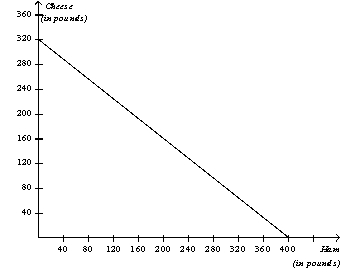 -Refer to Figure 3-11. Whenever Bonovia increases its production of ham by 1 pound per month, then it must decrease its production of cheese by
-Refer to Figure 3-11. Whenever Bonovia increases its production of ham by 1 pound per month, then it must decrease its production of cheese by
A) 0.75 pound.
B) 0.80 pound.
C) 1.00 pounds.
D) 1.25 pounds.
F) A) and C)
Correct Answer

verified
Correct Answer
verified
Multiple Choice
Figure 3-10
Alice and Betty's Production Possibilities in one 8-hour day.

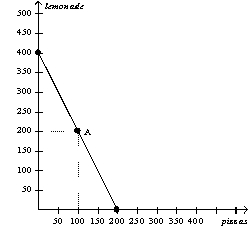
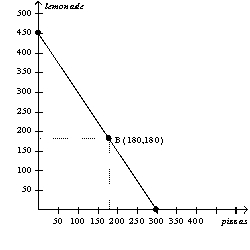 -Refer to Figure 3-10. What are Alice and Betty's opportunity costs of 1 pizza?
-Refer to Figure 3-10. What are Alice and Betty's opportunity costs of 1 pizza?
A) Alice's opportunity cost of 1 pizza is 1/2 of a pitcher of lemonade and Betty's opportunity cost of 1 pizza is 2/3 of a pitcher of lemonade.
B) Alice's opportunity cost of 1 pizza is 1 pitcher of lemonade and Betty's opportunity cost of 1 pizza is 3 pitchers of lemonade.
C) Alice's opportunity cost of 1 pizza is 2 pitchers of lemonade and Betty's opportunity cost of 1 pizza is 1.5 pitchers of lemonade.
D) Alice's opportunity cost of 1 pizza is 400 pitchers of lemonade and Betty's opportunity cost of 1 pizza is 450 pitchers of lemonade.
F) A) and C)
Correct Answer

verified
Correct Answer
verified
Showing 261 - 280 of 413
Related Exams